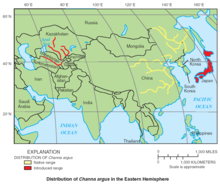Northern Snakehead
| Northern snakehead | |
|---|---|
 |
|
| Scientific classification | |
| Kingdom: | Animalia |
| Phylum: | Chordata |
| Class: | Actinopterygii |
| Order: | Perciformes |
| Family: | Channidae |
| Genus: | Channa |
| Species: | C. argus |
| Binomial name | |
|
Channa argus (Cantor, 1842) |
|
 |
|
| Asian distribution of Channa argus (native in yellow, introduced in red). Source: USGS 2004 | |
The northern snakehead (Channa argus) is a species of snakehead fish native to China, Russia, North Korea, and South Korea, ranging from the Amur River to Hainan. It has been introduced to other regions where it is considered invasive. In Europe, the first report of the species was from Czechoslovakia (now the Czech Republic) in 1956. In the United States, the fish is considered to be a highly invasive species. In a well-known incident, several were found in a pond in Crofton, Maryland, in June 2002, which led to major media coverage and two movies.
The distinguishing features of a northern snakehead include a long dorsal fin with 49–50 rays, an anal fin with 31–32 rays, a small, anteriorly depressed head, the eyes above the middle part of the upper jaw, a large mouth extending well beyond the eye, and villiform teeth in bands, with large canines on the lower jaw and palatines. It is generally reported to reach a length up to 85–100 cm (2 ft 9 in–3 ft 3 in), but specimens approaching 150 cm (4 ft 11 in) are known according to Russian ichthyologists. The largest registered by the International Game Fish Association weighed 8.05 kg (17 lb 12 oz), although this was surpassed by a 8.36 kg (18.42 lb) northern snakehead caught in 2016.
Its coloration is a golden tan to pale brown, with dark blotches on the sides and saddle-like blotches across the back. Blotches toward the front tend to separate between top and bottom sections, while rear blotches are more likely to be contiguous. Coloration is nearly the same between juveniles and adults, which is unusual among snakeheads, and is similar to Channa maculata, but can be distinguished by two bar-like marks on the caudal peduncle (where the tail attaches); in C. maculata, the rear bar is usually complete, with pale bar-like areas before and after, while in C. argus, the rear bar is irregular and blotched, with no pale areas around it.
...
Wikipedia
